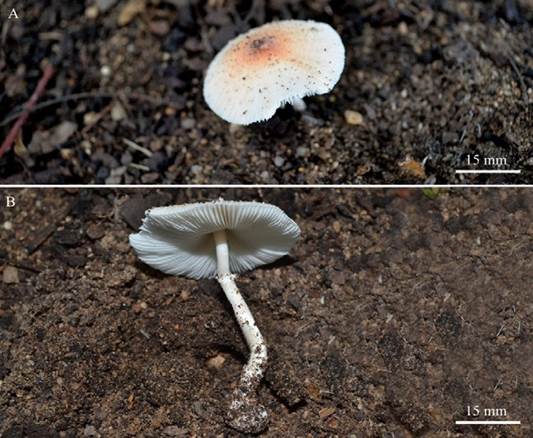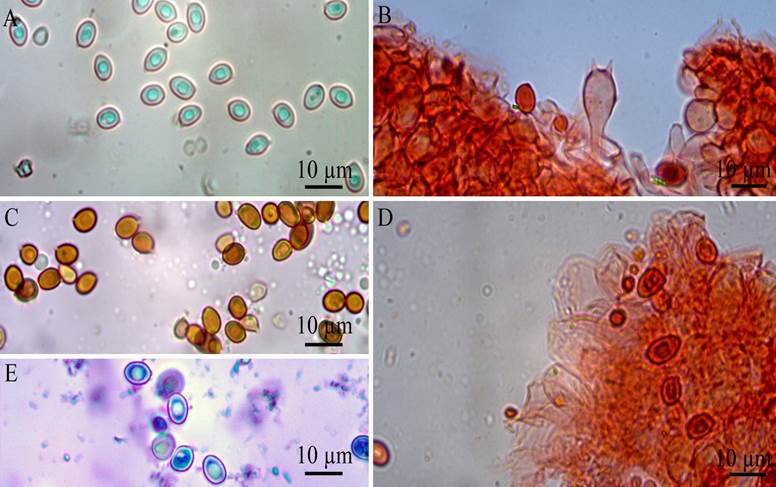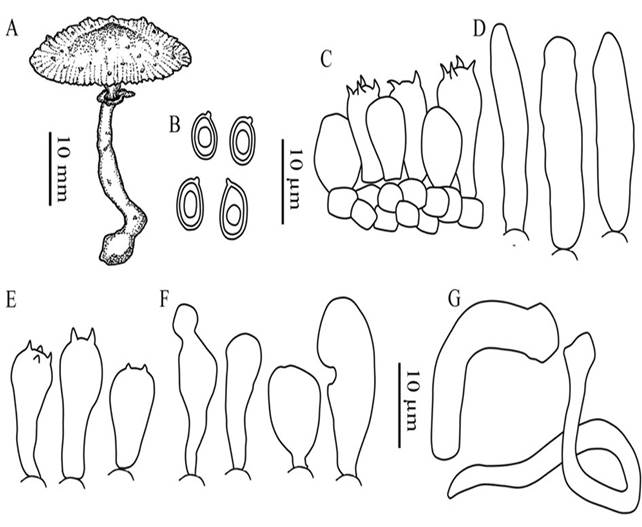Introduction
Leucocoprinus Pat., 1888 (Agaricaceae) is characterized by its small or sometimes medium-sized basidiomes with a delicate and thin context, membranous pileus generally possessing a plicate-striate margin, pale hymenophore, free lamellae, and central stipe (Singer, 1986; Vellinga, 2004a). Microscopically, it can be recognized by metachromatic and dextrinoid basidiospores with or without evident germ pore, and the presence of pseudoparaphyses (Justo et al., 2020, 2021; Kumar & Manimohan, 2004; Singer, 1986). Leucocoprinus species are saprobic, growing solitarily or gregariously on soil, mostly in the tropics (Guzmán & Guzmán-Dávalos, 1992; Singer, 1986; Vellinga, 2001).
Phylogenetic studies of the Agaricaceae indicate that Leucocoprinus and Leucoagaricus Locq. ex Singer, 1948 are intermixed within a single clade, but without bootstrap support, and this large genus can be recognized or divided into smaller groups (Vellinga, 2004a: 373). Subsequent studies showed that Leucoagaricus/ Leucocoprinus clade is monophyletic only in the rpb2 phylogeny, and both genera can be split in other phylogenies according to morphology (Vellinga et al., 2011: 498). These works also revealed Micropsalliota Höhn., 1914 and Allopsalliota Nauta & Bas, 1999 clustered in a Leucocoprinus/Leucoagaricus clade close to reddening members like Leucoagaricus americanus (Peck) Vellinga, 2000.
Leucocoprinus has a pantropical distribution comprising approximately 50 species worldwide (He et al., 2019; Wijayawardene et al., 2020). In Brazil, at least 14 taxa have been reported from several states belonging, up to now, to Atlantic, Amazon, and Caatinga biomes (Albuquerque & Victoria, 2012; Albuquerque et al., 2006; Capelari & Gimenes, 2004; Ferreira & Cortez, 2012; Nascimento & Alves, 2014; Wartchow et al., 2008). In relation to the northeast region, knowledge is limited to 3 species, L. birnbaumii (Corda) Singer, 1962, L. cretaceus (Bull.) Locq., 1945, and L. fragilissimus (Ravenel ex Berk. & M.A. Curtis) Pat., 1900, reported from Atlantic forest and Caatinga of Ceará and Pernambuco, revealing a low number of taxa (Nascimento & Alves, 2014; Wartchow, 2018; Wartchow et al., 2008).
The ‘Cariri Paraibano’ region constitutes an area of the Caatinga biome (IBGE, 2004) and has a very high dry climate, with an annual rainfall average of only 900-2,500 mm (Nascimento & Alves, 2008). This microregion of the state of Paraíba, located on a “dry diagonal”, where the aridity degree bioclimate can vary between 0.14 (arid climate) for the Eastern Cariri and 0.22 (semi-arid climate) for Western Cariri (Nascimento & Alves, 2008). The region suffers from a high level of desertification, currently intensified by deforestation due to implantation of agriculture and livestock (Sousa et al., 2008). These anthropic pressures in general result in soil depletion, biological diversity loss, and species extinction (Alves, 2009), since the Caatinga biome houses many endemic species (Leal et al., 2003). Despite many problems related to loss of biodiversity in this region, floristic studies reported approximately 400 plant species belonging to 90 families from ‘Cariri Paraibano’ showing a satisfactory richness in some well-preserved areas (Alves, 2009; Barbosa et al., 2007).
During studies of fungal diversity of Paraíba in Northeast Brazil, an interesting species of Leucocoprinus sensu stricto (i.e., species bearing sulcate-plicated pileus and presence of pseudoparaphyses, Singer 1986) with colors not yet observed for this group and basidiospores lacking a germ pore was collected in the ‘Cariri Paraibano’ region. Based on morphological analysis, Leucocoprinus rhodolepis is proposed as a new species, improving the knowledge of Northeastern Brazilian mycota.
Materials and methods
The new species was collected at the ‘Reserva Particular do Patrimônio Natural (RPPN) Fazenda Almas’, in the municipality of São José dos Cordeiros, Paraíba State (7°28’45” S, 36°54’18” W). With an area of 5,502.92 hectare, this reserve belongs to the Caatinga biome (IBGE, 2004), and is composed of a vegetational type called arborous-arbustive Caatinga (Velloso et al., 2002), and a semi-arid hot climate with annual precipitation of 500 to 800 mm and temperatures varying between 26°C and 30°C (Barbosa et al., 2015). It is located in the Western Cariri and corresponds to the largest private reserve in the Caatinga biome of this state (Lima & Barbosa, 2014). For the study, usual methodologies for agaricoid fungi analysis were used (Singer, 1986) and color codes follow Online Auction Color (2004). The statistics of the basidiospores were based on 40 measurements, Q is the quotient between the length and width, and Qm is the median value of Q. The holotype is deposited at JPB (Thiers, 2021, continuously updated).
Description
Leucocoprinus rhodolepis Ferretti-Cisn. & Wartchow, sp. nov. (Fig. 1-3)

Figure 1 Leucocoprinus rhodolepis (holotype). Basidiome. A, Detail of the pileus surface; B, detail of the hymenophore.
Mycobank: MB 838894
Diagnosis. Differs from other Leucocoprinus species by a combination of the following characters: pinkish tints of the pileal squamules, basidiospores measuring 6.9-7.8 × 4.9-5.9 µm, lacking a germ pore, and cheilocystidia measuring 15.5-27.5 × 7.1-11.2 µm, clavate to broadly clavate, rarely ventricose-capitate.
Basidiomata lepiotoid (Largent, 1986). Pileus up to 36 mm, plano-convex umbonate, surface squamulose; grayish-pinkish-orange (OAC 613) at center, disrupting into pinkish orange (OAC 617), then light pink (OAC 620), small squamules more scarce towards margin, on a white (OAC 909) ground; margin very thin, acute, finely plicate-striate, straight to slightly decurved (Fig 1A); context very thin, submembranous, white, unchanging. Lamellae free, crowded to subcrowded, white (OAC 909), edge mostly even, sometimes finely serrulate, concolorous with the side; lamellulae frequent, with 3 lengths (Fig. 1B). Stipe 50 × 4 mm, central, cylindrical to compressed, slightly curved at the base, white (OAC 909) to very pale grayish green (OAC 893); surface smooth, glabrous; base bulbous, ranging to 11 mm diam.; annulus attached on the upper part, funnel shaped, small, white (OAC 909), striate at the inferior part of the annulus (Fig. 1B). Spore print not obtained. Basidiospores 6.9-7.8 (-8.8) × 4.9-5.9 µm, av. 7.7 × 5.1 µm, Q = 1.32-1.59 (-1.79), Qm = 1.47, ellipsoid, rarely oblong, lacking a germ pore, slightly thick-walled, hyaline and colorless in 3% KOH (Fig. 2A), dextrinoid (Fig. 2C), metachromatic in cresyl blue (Fig. 2E) mounts; hilar appendix subapical (Figs. 2A, 3A). Basidia 17.620.6 × 7.8-9.8 (-10.8) µm, clavate, 2-4-spored, hyaline, sterigmata 1-3 µm long, surrounded by abundant sphaeropedunculate to balloon-shape pseudoparaphyses (Figs. 2B, 3C, 3E). Pleurocystidia absent. Lamellar edge sterile, composed of numerous cheilocystidia, 15.5-27.5 × 7.1-11.2 µm, clavate to broadly clavate, rarely ventricosecapitate, hyaline, thin-walled (Figs. 2D, 3F). Lamellar trama regular, composed by cylindrical hyphae, 4.15.6 µm in diam., thin-walled, colorless. Pileus covering a cutis composed of loosely arranged to pileus surface under microscope elements, mostly cylindrical, 62.5-93.7 × 11.2-22.5 µm, thin walled, pale colorless (Fig. 3D), more abundant at disc. Oleiferous (thrombopleurous) hyphae infrequent to rare, present in lamellar trama and pileus, measuring 4.1-13.3 µm wide (Fig. 3G). Clamp connections absent from all tissues examined.

Figure 2 Leucocoprinus rhodolepis (holotype): A, Basidiospores in 3% KOH; B, basidiospores and 1 basidium in Congo red; C, basidiospores in Melzer’s reagent; D, cheilocystidia in Congo red; E, basidiospores in Cresyl blue.

Figure 3 Leucocoprinus rhodolepis (holotype) microscopic drawing: A, Basidiome; B, basidiospores; C, basidia mixed with pseudoparaphyses, and subhymenium; D, pileus covering terminal elements; E, basidia; F, cheilocystidia; G, oleiferous hyphae of the umbo.
Taxonomic summary
Holotype: Brazil. Paraíba state, São José dos Cordeiros, RPPN Fazenda Almas, solitary on soil among litter, 26 Feb 2019, leg. A.G.S. Silva-Filho 08-2019 (JPB 64603).
Etymology: from Greek (Borror, 1960) rhodo (= rosecolored), and lepis (= squamules/scales). Due the pinkish squamules on pileus centre.
Habitat and distribution: solitary on soil surrounded by vegetation of Caatinga, only known from the type locality.
Conservation status: the species is only known from the type locality. This place has been the focus of previous floristic studies (Agra et al., 2007; Barbosa et al., 2007) and is considered a somewhat well-preserved area. In addition, it is difficult to define the population of L. rhodolepis due to the extremely dry weather and non-seasonal rains in the region. Thus, we consider the taxon as belonging to the category of ‘Data Deficient’ (DD), and more information needs to be gathered before evaluation against IUCN criteria (IUCN, 2019).
Remarks
Leucocoprinus rhodolepis can be easily recognized in the field by its small basidiomata with white pileus covered by orange-pink squamules on the center and basidiospores without a germ pore. These features are infrequent among Leucocoprinus sensu stricto (Singer 1986). The Neotropical species Lepiota roseolamellataDennis, 1952 was described as having a plicate-striate surface with white then pink pileus and basidiospores lacking a germ pore, which might be a member of Leucocoprinus. The species can be separated by its smaller pileus 10 mm in diam., white then pink lamellae, more fragile annulus, narrower basidiospores (5.5-7 × 2.5-3 µm), and habit growing on rotten logs (Dennis, 1952). Later, Pegler (1983) revised this species and observed more features such as the absence of clamp connections and a pseudoparenchymatous subhymenial layer. This species has certain similarities with the entity described here, such as the presence of a small annulus and the size and form of the basidiospores, but some differences like the glabrous pileus, pink lamellae, and the smaller pileus distinguish L. roseolamellata from L. rhodolepis (Pegler, 1983).
A species recently mentioned as having pinkish gray hues around the pileus center is L. antillarumJusto, Bizzi & Angelini, 2021 from the Dominican Republic. However, the scales are more scattered and brownish gray, brown-ocher or whitish, the basidiospores are smaller (5-7 × 3.5-5 µm) and amygdaliform, and the cheilocystidia are larger (35-92 × 9-27 µm; Justo et al., 2021).
The species L. rubrosquamosus (Rick) Raithelh., 1991 should also be noted. This species was described under Lepiota (Pers.) Gray, 1821 by Rick (1920) as having small stature, fire-red squamules, whitish margin, small annulus, and small basidiospores (4.5 × 3 µm). Later, Singer (1951) recombined the species to Leucoagaricus rubrosquamosus (Rick) Singer, 1951 (1949). Subsequent study of the type revealed that exsiccata, found in Farlow Herbarium (FH) was deposited under the name ‘Lepiota rubrofibrillosa’ bears reticulate basidiospore walls (Singer, 1953) characteristic of the genus RugososporaHeinem., 1973 (Heinemann, 1973). Finally, Raithelhuber (2004) concluded that Singer reviewed a different sample and proposed the name Leucocoprinus rubrosquamosus based on material deposited in the herbarium PACA. Thus, this species differs from L. rhodolepis at least in the reddish squamules, and proportionally longer basidiospores (7.810 × 4.2-4 µm) although there is no mention of the presence or absence of a germ pore (Raithelhuber, 2004).
Microscopically L. rhodolepis produces basidiospores without a germ pore, a feature also observed in another 16 species: Leucocoprinus antillharumJusto, Bizzi & Angelini, 2021, L. aureofloccosus (Henn.) Bon, 1981, L. cygneus (J.E. Lange) Bon, 1978, L. dominguensisJusto, Bizzi, Angelini & Vizzini, 2020, L. flavescens (Morgan) H.V. Sm., 1981, L. fuligineopunctatusJusto, Bizzi & Angelini, 2021, L. heinemannii Migl., 1987, L. lanzonii Bon, Migl. & Brunori, 1989, L. medioflavus (Boud.) Bon, 1976, L. microlepisJusto, Bizzi & Angelini, 2021, L. parvipileusJusto, Bizzi, Angelini & Vizzini, 2020, L. pepinosporus Heinem., 1977, L. scissusJusto, Bizzi & Angelini, 2021, L. straminellus (Bagl.) Narducci & Caroti, 1995, L. submontagnei Heinem., 1977, and L. tephrolepisJusto, Bizzi, Angelini & Vizzini, 2020, (Table 1) (Birkebak, 2010; Candusso & Lanzoni, 1990; Heinemann, 1977a, b; Justo et al., 2020, 2021; Smith, 1981).
Table 1 Comparison between Leucocoprinus rhodolepis and related species.
| Species | Pileus color | Umbo color | Squamules | Basidiospores (µm) | Cheilocystidia (µm) | Reference |
|---|---|---|---|---|---|---|
| Leucocoprinus antillarum | white | brown-ocher, ocheryellowish | brownish gray, brown-ocher or whitish | 5.5-7 × 3.5-5 | 35-92 × 9-27 | Justo et al. (2021) |
| L. aureofloccosus | sulfur yellow | sulfur yellow | golden floccose | 5-7 × 2.5-3 | not mentioned | Candusso & Lanzoni (1990) |
| L. cygneus | white slightly achraceous | white slightly achraceous | greyish granulose | 6-7 × 3.5-4.5 | Vellinga (2001) | |
| L. dominguensis | white | gray-black | dark-gray to black | 4.5-6 × 3- 4 | 23-46 × 5.5-12.5 | Justo et al. (2020) |
| L. flavescens | sulfur yellow to white tinted with sulfur yellow to naphthalene yellow | barium yellow to amber yellow or faintly tinted brown | not mentioned | 4.4-5.9 × 3.6-4.8 | 11-24.2 × 5.5-13.2 | Birkebak (2010) |
| L. fuligineopunctatus | white | dark brown, brown-black, brown sooty | dark brown, brown-sooty | 5.5-7.5 × 3.5- 4.5 (-5) | 20-40 × 6-19.5 | Justo et al. (2021) |
| L. heinemannii | white | black | grey-violet | 6-7.5 × 3.3-4.2 | 24-32 × 7-10 | Candusso & Lanzoni (1990) |
| L. medioflavus | white | light brown | pale yellow to brownish yellow | 5-6.5 × 3-4 | 19-42 × 9-16 | Candusso & Lanzoni (1990) |
| L. microlepis | white | brown-black | brownish gray | 5-7 × 3.5-5 | 16-57 × 8-20 | Justo et al. (2021) |
| L. lanzonii | milky white | brownish | brownish | 5-6.5 × 3.5-4.5 | 30 × 11 | Candusso & Lanzoni (1990) |
| L. parvipileus | white | gray-blackish | gray | 5-7 × 3-4.5 | 22-41 × 7.5-15 | Justo et al. (2020) |
| L. pepinosporus | white | grayish brown | brownish | 11.2-13.5 × 7.4-8.1 | 45-50 × 14-20 (28) | Heinemann (1977a; 1977b) |
| L. rhodolepis sp. nov. | white | grayishpinkishorange | pinkish orange to light pink | 6.9-7.8 × 4.9-5.9 | 15.5-27.5 × 7.1-11.2 | This study |
| Lepiota roseoalba | orange-pink to seashell pink | strawberry pink | not mentioned | 6.5-10 × 4-5 | 34-43 × 4.5-11 | Pegler & Rayner (1969) |
| Lepiota roseolamellata | white to flesh-pink | pinkish | not mentioned | 5.5-7 × 2.5-3 | 16-25 × 12 | Dennis (1952) |
| L. scissus | white | brownish ocher | brownish ocher | 6-8 × 4-6 | 20-52 × 6-14 | Justo et al. (2021) |
| L. straminellus | white to yellowish white | pale yellow | white to light yellow | 5-7.5 × 3-4.5 | 15-40 × 6-12 | Kumar & Manimohan (2009), Campi et al. (2015) |
| L. submontagnei | creamy white | brown | brown | 5.5-6.6 × 3.3-4.4 | 25.3-66 × 10-22 | Heinemann (1977a; 1977b) |
| L. tephrolepis | white | gray | gray-ash | 5.5-7 × 3-4 | 23-46 × 55-12.5 | Justo et al. (2020) |
Among the taxa cited, only L. cf. medioflavus was reported from Brazil, occurring in the Atlantic Forest of Rio Grande do Sul (Rother & Silveira, 2008, 2009). However, this material requires a more detailed analysis before confirming its specific status.
Leucocoprinus pepinosporus, L. cygneus, L. submontagnei, L. lanzonii, and L. scissus readily differ in the pileus bearing brownish coloration. Additionally, they present other morphological differences: L. pepinosporus has pinkish tints on the stipe, larger basidiospores (11.213.5 × 7.4-8.1 µm), and larger cheilocystidia (45-50 × 14-20 µm, Heinemann, 1977a; 1977b); L. cygneus has grayish granulous flocks on the pileus center and smaller basidiospores (6-7 × 3.5-4.5 µm; Vellinga, 2001); L. submontagnei has dark brown squamules at the center, a more plicate striated pileus, and amygdaliform basidiospores (6.5-8.1 × 4.2-5.1 µm; Heinemann, 1977a; 1977b); L. lanzonii was referred to as having brownish orange tints and also differs in its smaller basidiospores (56.5 × 3.5-4.5 µm) and the slightly larger clavate cylindrical cheilocystidia ranging to 60 × 11 µm (Candusso & Lanzoni, 1990); and L. scissus, although described with basidiospores similar in size (6-8 × 4-6 µm), differs in the brown ocher scales on its pileus, and longer cheilocystidia (20-52 × 6-14 µm; Justo et al., 2021).
The other 4 species bearing basidiospores without a germ pore have a yellowish pileus and smaller basidiospores: L. aurefloccosus (5-6.5 × 3.5-4.5 μm; Candusso & Lanzoni, 1990); L. flavescens (4.4-5.9 × 3.6-4.8 µm; Birkebak, 2010); L. straminellus (5-6 × 4-5 μm; Candusso & Lanzoni, 1990; Campi et al., 2015); and L. medioflavus (5.5-6.5 x 3.5-4.2 µm; Candusso & Lanzoni, 1990). Finally, L. heinemannii and other recently described species (L. dominguensis, L. fuligineopunctatus, L. microlepis, L. parvipileus, and L. tephrolepis) differ in the black, purplish black, gray-ash squamules on the pileus center, and the slightly longer cheilocystidia ranging to 46 µm long (Candusso & Lanzoni, 1990; Justo et al., 2020, 2021; Mohr & Ludwig, 2004).
Thus, we consider that our sample collection presents unique features compared to other Leucocoprinus taxa. It corresponds to a sample in perfect condition when gathered, allowing a full and detailed examination of its macro- and microscopical features, which we considered distinct enough to propose it as a new taxon.
Implication for conservation
The northeastern semi-aridity is caused by natural phenomena, but has been intensified by anthropic actions (Sousa et al., 2008). Desertification brings a scarcity of natural resources, which results in greater social, economic, and environmental vulnerabilities, which are reinforced by the absence of consistent public policies (Sousa et al., 2008). Among the factors that contribute to the processes of degradation of the Cariri’s vegetation are the supply of wood for various economic activities in the state of Paraíba, and extensive and semi-extensive local livestock farming. Thus, the sustainability of the Caatinga biome must be accompanied by a policy to combat the degradation of vegetation cover, as pointed out by Alves (2009).
According to Vellinga (2004b), deforestation in areas, particularly in the tropics, may extinguish many habitats for lepiotaceous species. She argued that the conservation of existing diversity would need public policies, supported by new ecological research, more taxonomic studies, and recording projects. In the last decades we observed an increase of recording and describing species of Agaricaceae in Brazil; however, some areas are still underexplored (Nascimento & Alves, 2014; Wartchow et al., 2008). The discovery of this new species in a region that suffers severe aridity shows the importance of inventories of agaricoid fungi in the Brazilian semi-arid region.











 nova página do texto(beta)
nova página do texto(beta)


